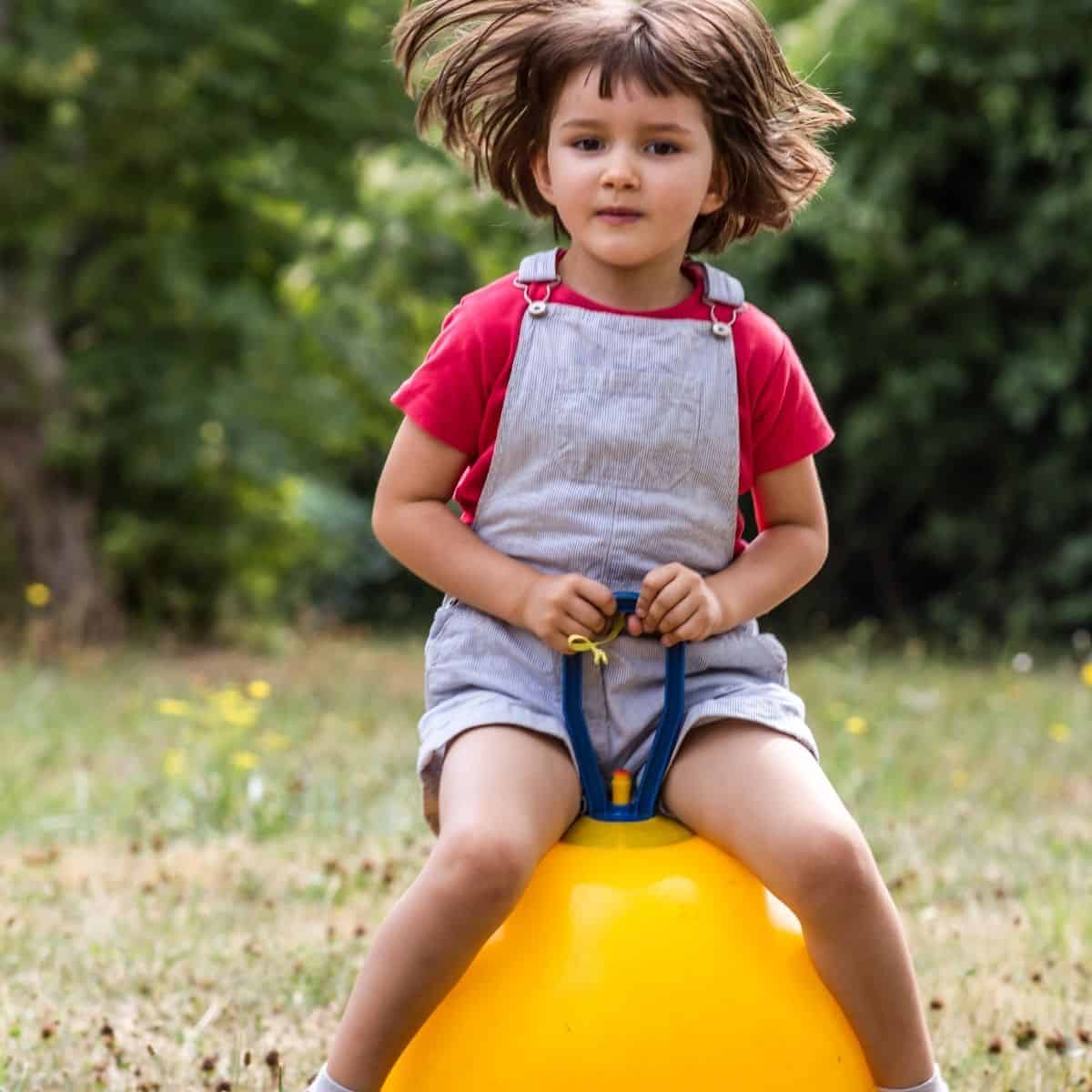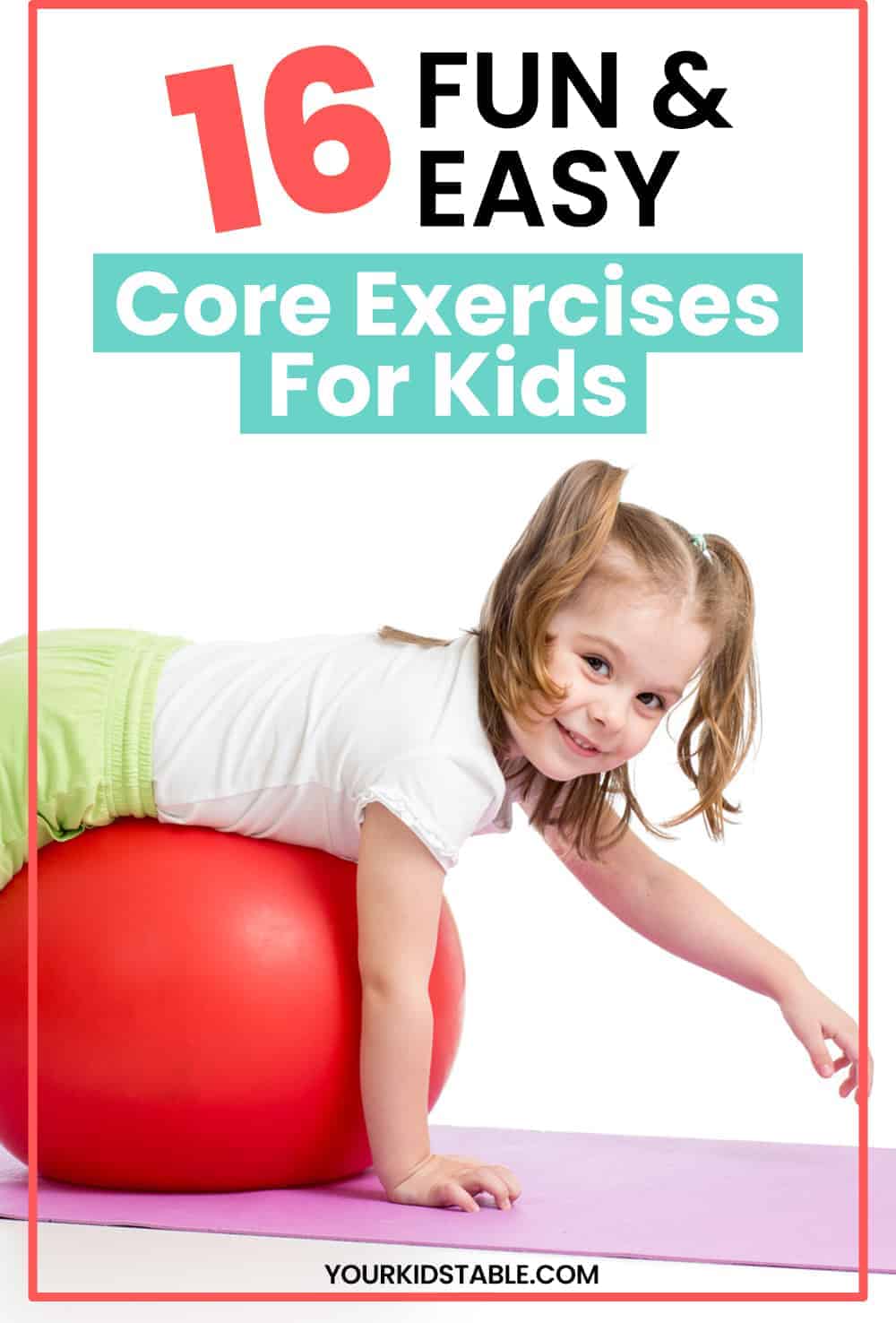Core exercises help kids gain strength for fine motor activities. Core strength starts to develop in babies! The strength and stability continues to develop as a child grows through toddler, preschool, and school-age years.
Many times as an occupational therapist, I’d have a new child assigned to my caseload for fine motor skills. They might be having a hard time using scissors, feeding themselves, coloring, or writing with letters or shapes.
And, while the problem with writing or tying shoes is apparent to everyone, what’s not is that part of their fine motor delay may have to do with their core strength.
Yes, their core. Their abs, so to speak.
But, core strength also affects a variety of other aspects of development from gross motor skills to eating to focusing in school!
And, more kids than ever have poor core strength.
Since this is so important, I invited my fellow OT who’s an expert in core strength and exercises, Amy Hathaway from Develop Learn Grow, to break down exactly what you need to know. And, she’s sharing 16 easy exercises to help your child increase their core strength!
How Do Children Develop Good Core Strength?
Gross motor and fine motor development starts with good core strength. It’s a very important foundation for kids.
Babies start developing core strength when they play on the floor. Floor time gives opportunities for rolling, lying on the side, and reaching for those little toes! Tummy time strengthens muscles for sitting and for fine motor development in the arms and hands.
Older babies and toddlers develop good core strength with continued floor play, side sitting, and crawling. As they get bigger, they climb and move around all over – inside and outside.
Toddlers and preschoolers learn to move their body on uneven surfaces, small bikes, and on climbing structures. They are successful on playground equipment and swings.
Additionally, these young kids are able to sit upright in a small chair for a fine motor activity. Or, they can stand in one place to draw a picture at an easel or play with magnets on the fridge.
Older children need good core stability to complete more complex movements on the playground and in Phys Ed. More importantly, they need a strong core so they can sit well for learning tasks and fine motor activities.
What is Core Strength in Kids?
Core strength involves the muscles in the core, or the trunk. The core muscles include the muscles on the back, the belly, and the sides of the trunk.
Stability in the core promotes better use of the shoulders during play and fine motor activities.
Many parents that I’ve worked with often share that tummy time was difficult for their child. Their baby cried and didn’t like it. Or, the parent didn’t feel that it was safe to leave their baby on the floor because of older siblings or pets.
The families put the babies in a bouncer, saucer, or stroller to keep them safe. Totally understandable!
However, core strength and core stability was lacking in these kiddos. As an occupational therapist, I needed to use core strength exercises in the babies and toddlers.
But the exercises don’t stop there! I have had, currently have, and will continue to have preschool and school-age kids that need better core stability.
Part of my role as an occupational therapist includes educating teachers and parents on ways to improve core strength. I address it during therapy sessions… but it helps kids more when they have opportunities every day to strengthen their bodies.

Why Are Core Exercises Important for Kids?
Core exercises strengthen and stabilize the body so that the arms and hands can work better. If the core remains still and the body upright, then strength and stability can develop in the arms and hands.
A strong core keeps the body still during balancing tasks. Kids are able to move smoothly and efficiently.
They complete daily tasks without getting tired. Kids can play on the floor or sit in a chair without constantly changing position or propping their head.
Muscles in the top of the back, the neck, and the shoulders need to be strong. This helps kids to sit in a chair with good posture.
They sit upright without getting tired. Again, without wiggling around or resting their head in their hands.
The upright posture and shoulder strength helps with fine motor development. A child uses their hands better when their core, shoulders, and forearms stay still (are stable.)
This allows the hands to be strong. It helps the fingers move properly, as they are designed to!
Additionally, kids need good core strength and good posture for optimal breathing. If kids sit upright with good posture, they breathe better. This gets more oxygen to their brains! More oxygen means improved focus and attention!
Over the decades of my career, I’ve seen more and more of a need for core strength exercises in kids.
The increase in technology and screen use has greatly (and negatively) impacted motor development. More screen time means less play using the hands. And less active play time spent outdoors.
Core Activities and Exercises for Kids
First, I’m going to share core exercises that require a partner and/or some kind of equipment. Then, I’ll share exercises that require no equipment at all.
When I support parents and teachers, I try to find exercises that are easy to use during routines. I know how busy life is… adding more activities can always be challenging!
I think you’ll be surprised at how easy these strength exercises will be for your kiddos. Most are play activities. Or, they can be done with a play activity.
Once you make them a consistent part of the daily routine, it doesn’t feel like something extra!
Additional benefits of some of the exercises are that they help with fine motor skills. They strengthen muscles in the hands to help with grasp development. Good posture and proper pencil grasp development are necessary when kids learn to form letters and numbers properly.
More importantly, there are sensory benefits to many of the exercises listed below! They provide the body with deep pressure input and heavy work for the muscles.
This input is great for the brain and nervous system. Check out 25 Brain Breaks for Kids – Increase Focus and Attention for more ideas (and for a free printable!)
Here’s the list of the 16 core exercises for you to try with your kids…

Core Strength Exercises That Require a Peer, Adult, or Equipment
1. Wheelbarrow Walk – Hold the ankles as kids “walk” on their hands. If your kids struggle a little, hold closer to the knees. Make sure they don’t twist their core as they “walk” on their hands.
2. Twister – The stretching and holding body positions is great for the core muscles. Pushing through open palms also strengthens the hands.
3. Sitting and Bouncing on a Therapy Ball – This activates and “wakes up” the muscles along the spine. Also, rocking side to side or back and forth strengthens more core muscles.
4. Bouncing on a Hop Ball – This is such a fun core and balance exercise for kids! Bonus: kids don’t know that they’re exercising! It activates muscles along the spine and it helps with hand strength!
5. Swinging – Simply sitting on a swing and holding on helps with hand and arm strength. It exercises the core and provides great movement input for the sensory systems.
6. Balloon Kicks in a Crab Walk Position – I love the crab walk! Sometimes space is limited so I like to have kids get in the crab position and just lift their legs. Kids often need a game and a target. A punch balloon or a balloon on a string works really well!
7. Scooter on Belly – A powerful way to strengthen the back and shoulders is to have kids lie on their bellies on a scooter. They place their hands on the floor to move themselves. BUT – they must keep the feet up in the air so the arms and upper back are only doing the work.
8. Stickers on Shoes – Place 5 stickers on each shoe. Kids stand and take one sticker from the left foot, then right, etc. This works on core ab strength and balance.
Core Stability Exercises for Kids – No Equipment Needed
9. Superman – Kids lie on their bellies on the floor and hold their legs and arms straight out from the body. Only the belly is on the floor! The lower back is slightly curved.
10. Rocking Egg – Kids lie on their back and bring their knees up to the chest. They lift the head off the floor and hug the knees. Only the lower back is balancing on the floor.
11. Military Crawl – A great upper body and core strengthening activity. Kids lie on their bellies and pull their body around with the elbows. This is easy to add to an obstacle course.
12. Crab Walk – This position requires so much coordination and strength for kids. The hands and feet are flat on the floor (belly up to the ceiling, bottoms lifted off the floor).
13. Bear Walk – The key in this position is to have kids straighten arms and legs so that the bottom is in the air. This requires more muscle work! Tell them to be quiet, baby bears to eliminate loud roaring!
14. Leg Scissors – Kids sit on the floor with legs straight out. They lean back into their hands (arms straight behind the body). Ab strength is needed to lift both legs and cross them over and under each other.
15. Vertical Surface Activities – A super easy way to work on core stability and shoulder strength. This is super important for wrist stability for fine motor tasks.
16. Prone Activities – Tummy time is important for kids of all ages! Kids should be encouraged to lie on their stomachs for play and learning tasks. Another easy way to build core stability.
The EASIEST Way to Start Using Core Exercises for Your Kids
The last two exercises listed are the easiest ways to start working on core strength and stability. I usually start with these two when I’m helping parents and teachers.
To make it more convenient for you, I created a one page PDF. The handout contains an explanation of why vertical surfaces and floor activities are important.
It lists several ways to simply change the position of an activity. The variety of positions that your kiddos can play in and/or work in help improve important core skills. AND, they target shoulder, arm, and wrist strength and stability. Skills that are needed for success with fine motor activities!
You’ll be surprised at how simple it is to change up a position during play and school work. Kids won’t even know they’re “exercising” at all!
AMY HATHAWAY is a pediatric occupational therapist with 20 years of experience. She is passionate about child development, learning, and sensory processing. Amy created DEVELOP LEARN GROW – a site that offers tools and tips for parents & teachers to help all children thrive. Amy shares simple OT strategies and activities to address important skills that are the foundation for learning. She is married with three children and works full time as a pediatric OT.

this isa great opportunity for kids like me!!!!!!!!!!!!!!!!!!!!please make one for every single day of the week
So glad you found this helpful! Make sure to check out our other resources on the blog! We have tons of them!
Best,
Laura
Your Kid’s Table occupational therapist
Hi, Great article. Would love to have a printout. Can you email me a PDF?
The site in the article is inaccessible. Thanks!
Hi, great article. would love to share with my families.
Can you send a PFD in order to save a copy? It doesn’t seem to be working in this post. Thank You!
Hi Beth,
Thanks for the feedback, we are glad you found this helpful! Unfortunately the pdf was hosted through a guest author and it looks like they no longer have it available. We will edit, thank you for bringing to our attention!
Best,
Your Kid’s Table team member
Very helpful information. Thanks for sharing! I’m trying to get a printable but it’s not going through. I also checked my spam, promotion, social folders and no luck. Would you be able to email me a copy please?
Hi Jess,
I just sent an email to your address listed here. Please let me know if you still don’t see it!
Best,
Laura
Your Kid’s Table team member
Hi! I keep clicking the link to get the printable sent to my email but it doesn’t seem to be working? I’ve checked my spam box as well . Would love to get a printable so I can put it up where we’ll see it everyday to remember to try at least one of the exercises/idea
Hi Ashlie,
I just sent, let me know if you continue to not see.
Best,
Laura
Your Kid’s Table team member
Thanks for this info. I’m planning to start my 6 year old doing these asap. He has autism and adhd, his motor skills are underdeveloped. So I have been looking for things I can do with him at home.
Hi there, thanks for reading and we hope you find these exercises helpful! If you are searching for anything else we can help with, let us know!
Best,
Laura, Your Kid’s Table team member
These are very helpful. Thank you very much…
I really enjoyed this information! It was helpful calling out things already do but help encourage it more. Please share more info from Amy – maybe wrist & neck because of iPads & bookbags!?! Thank you to the staff & Amy!
Hi Jen! Thanks for reaching out and sharing your feedback! So glad you found this post helpful, you are very welcome! We will keep this in mind for future posts! 🙂
Best,
Kalyn
Jen, I’m happy you enjoyed the info!
What a great thought about the neck and wrist… The vertical surface activities actually are so helpful in keeping the neck and wrist in the correct positions! And the floor activities really help the neck muscles!
Both are easy ways to help kids- Hope that helps 🙂
Hi Rosalie! Thanks for reaching out and sharing your feedback! So glad you found this post helpful, you are very welcome!
Best,
Kalyn